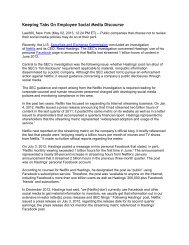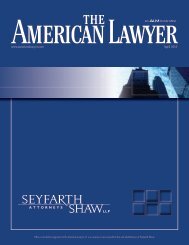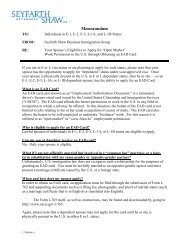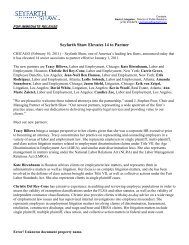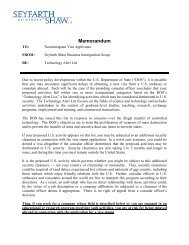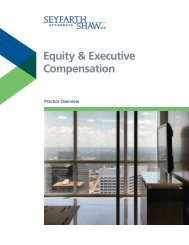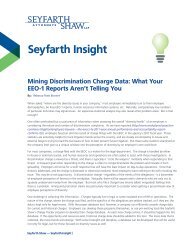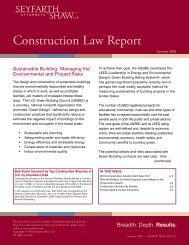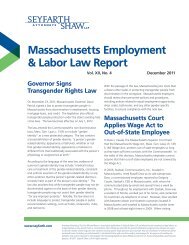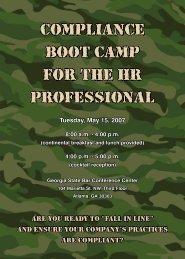Litigating California Wage & Hour and Labor Code Class Actions
Litigating California Wage & Hour and Labor Code Class Actions
Litigating California Wage & Hour and Labor Code Class Actions
You also want an ePaper? Increase the reach of your titles
YUMPU automatically turns print PDFs into web optimized ePapers that Google loves.
inquiry is on whether the parties conducted sufficient discovery to evaluate the<br />
claims themselves—something even the plaintiffs in the 7-Eleven case agreed<br />
the defendants had done. In such circumstances, the court should not<br />
disapprove a settlement based on a hypothetical or speculative measure of what<br />
might have been achieved by the negotiators.’” 491<br />
Furthermore, where relatively few class members object, that factor weighs against<br />
sustaining the objection. 492<br />
Objectors have better success in their objections when they identify procedural defects in<br />
the settlement process. For example, objections have been sustained when the class<br />
notice was excessively vague <strong>and</strong> confusing, or when class counsel failed to undertake<br />
sufficient discovery to properly evaluate the case. 493 In short, the odds of a successful<br />
objection are low if the parties conduct an adequate investigation, make the notice<br />
documents clear, set forth some rational basis for the settlement amount, <strong>and</strong> take<br />
adequate steps that class members are informed in their choices.<br />
F. Individual Settlements with Putative <strong>Class</strong> Members<br />
<strong>Class</strong> actions differ from individual actions in that most of the parties on whose behalf the<br />
action allegedly is advanced have no involvement in the case (<strong>and</strong> may be totally unaware<br />
of the case) until a court orders certification <strong>and</strong> notice. This aspect of class litigation has<br />
raised the question of whether employers should be entitled to communicate with putative<br />
class members before certification or whether they should be treated in the same manner<br />
as the named plaintiff, in which case the employer’s right to communicate with the<br />
employees would be severely restricted. 494<br />
It has been established law for more than twenty years that putative class members are not<br />
treated the same as parties <strong>and</strong> that there is no attorney-client relationship between a<br />
491<br />
492<br />
493<br />
494<br />
Id. at 1149-50; but see Kullar v. Foot Locker Retail, Inc., 168 Cal. App. 4th 116, 129 (2008) (parties are not excused<br />
from explaining what the claims potentially were worth <strong>and</strong> why less money was accepted: “While an agreement<br />
reached under these circumstances presumably will be fair to all concerned, particularly when few of the affected class<br />
members express objections, in the final analysis it is the court that bears the responsibility to ensure that the recovery<br />
represents a reasonable compromise, given the magnitude <strong>and</strong> apparent merit of the claims being released, discounted<br />
by the risks <strong>and</strong> expenses of attempting to establish <strong>and</strong> collect on those claims by pursuing the litigation.”).<br />
Id. at 1152-53 (out of a class of 5454 people, only nine objected <strong>and</strong> only 80 opted out).<br />
Cho v. Seagate Technology Holdings, Inc., 177 Cal. App. 4th 734, 747-48 (2009) (settlement disapproved without<br />
prejudice to issuance of new class notice where original notice was confusing as to who qualified as a class member);<br />
Kullar v. Foot Locker Retail, Inc., 168 Cal. App. 4th 116, 132-33 (2008) (case rem<strong>and</strong>ed for parties to better explain<br />
what information the parties considered in reaching settlement, <strong>and</strong> to allow objector limited discovery relevant to<br />
valuation of case).<br />
See generally Cal. Rule of Professional Conduct 2-100.<br />
Seyfarth Shaw LLP | www.seyfarth.com <strong>Litigating</strong> <strong>California</strong> <strong>Wage</strong> & <strong>Hour</strong> <strong>Class</strong> <strong>Actions</strong> (12th Edition) 110



